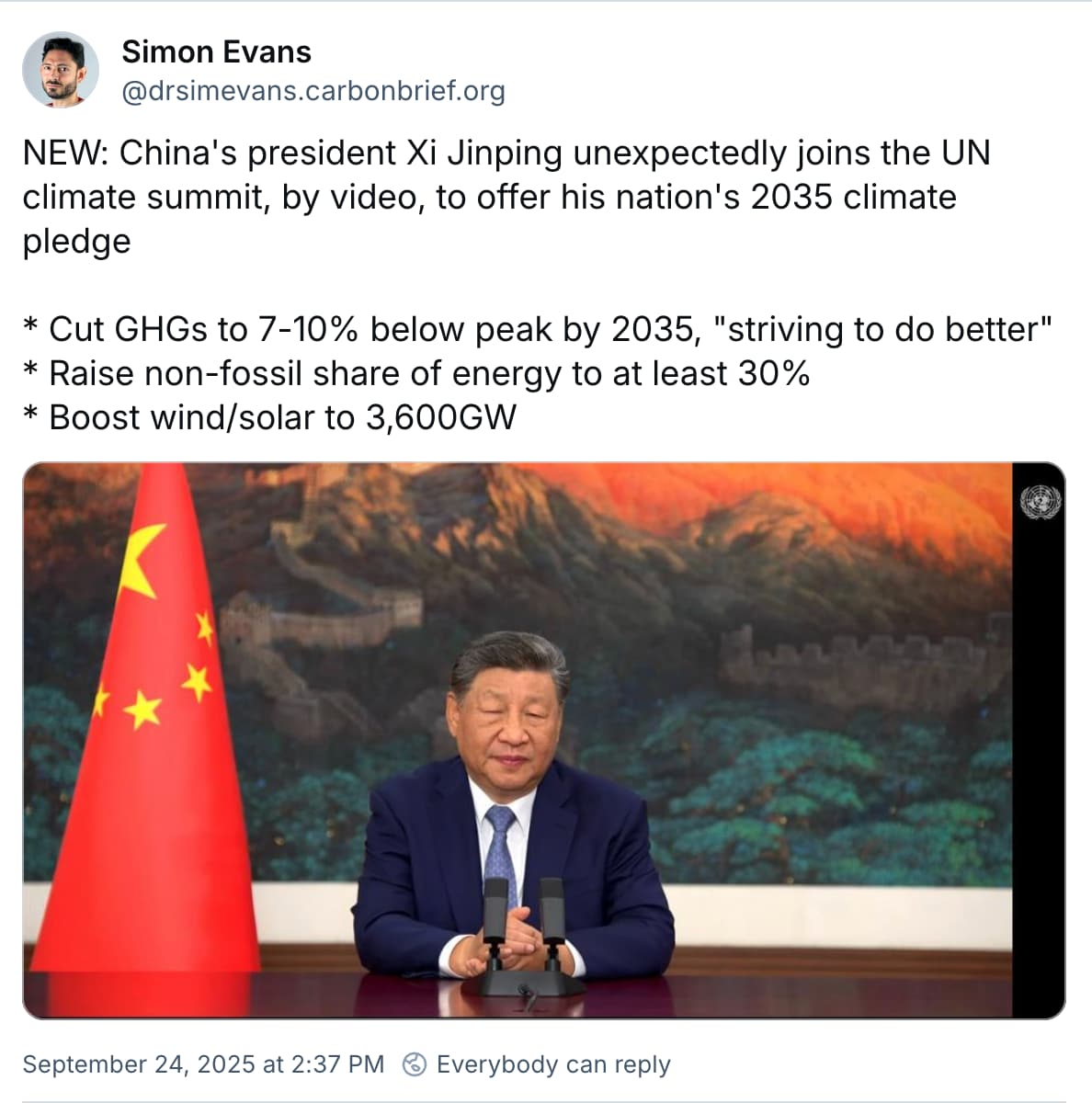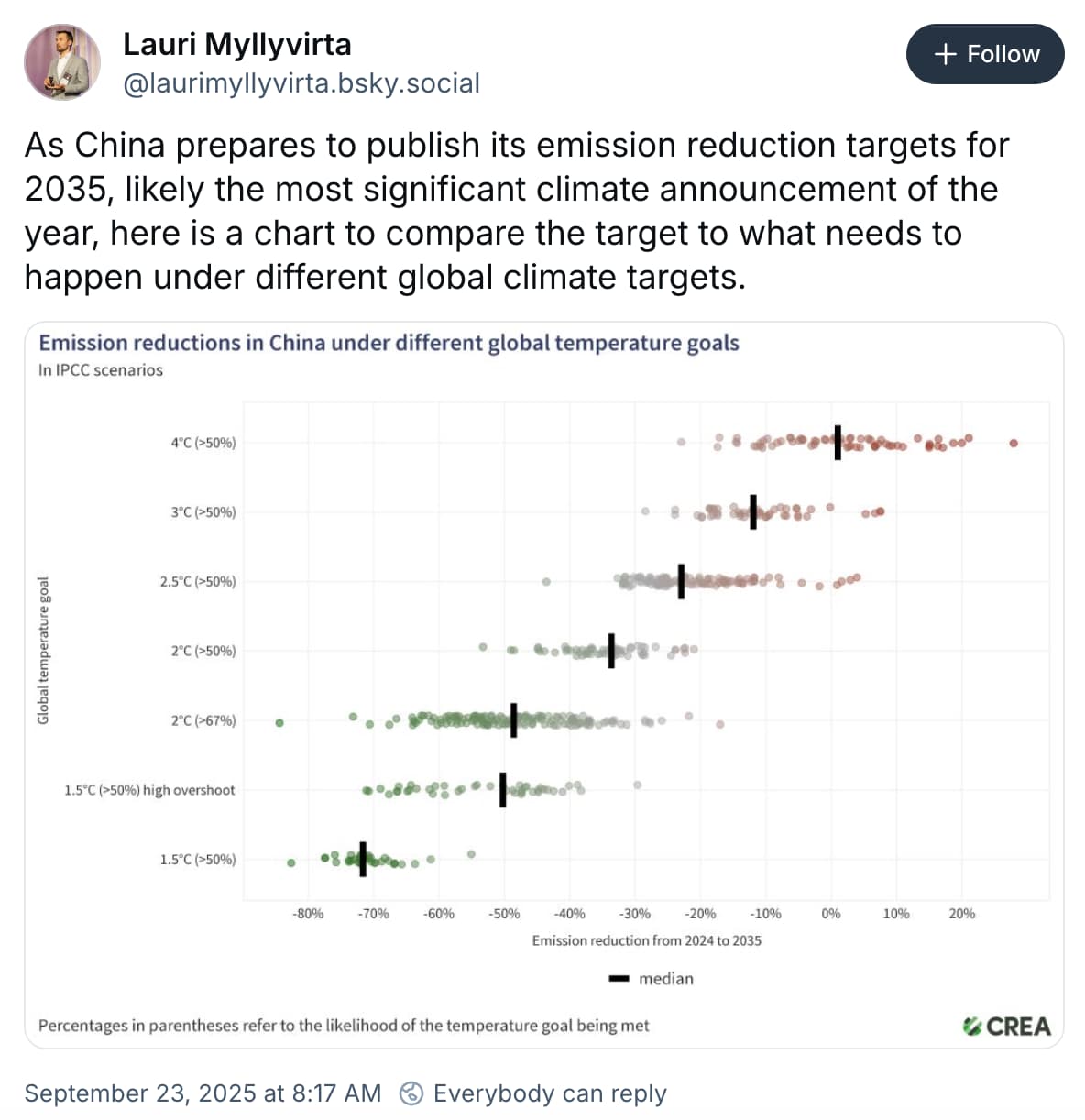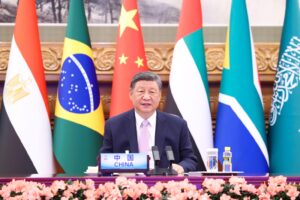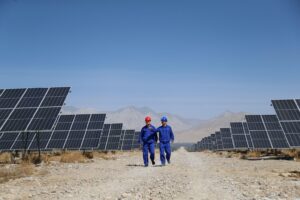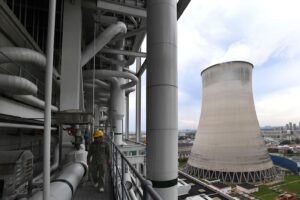President Xi Jinping has personally pledged to cut China’s greenhouse gas emissions to 7-10% below peak levels by 2035, while “striving to do better”.
This is China’s third pledge under the Paris Agreement, but is the first to put firm constraints on the country’s emissions by setting an “absolute” target to reduce them.
China’s leader spoke via video to a UN climate summit in New York organised by secretary general António Guterres, making comments seen as a “veiled swipe” at US president Donald Trump.
The headline target, with its undefined peak-year baseline, falls “far short” of what would have been needed to help limit warming to well-below 2C or 1.5C, according to experts.
Moreover, Xi’s pledge for non-fossil fuels to make up 30% of China’s energy is far below the latest forecasts, while his goal for wind and solar capacity to reach 3,600 gigawatts (GW) implies a significant slowdown, relative to recent growth.
Overall, the targets for China’s new 2035 “nationally determined contribution” (NDC) under the Paris Agreement have received a lukewarm response, described as “conservative”, “too weak” and as not reflecting the pace of clean-energy expansion on the ground.
Nevertheless, Li Shuo, director of the China Climate Hub at the Asia Society Policy Institute (ASPI), tells Carbon Brief that the pledge marks a “big psychological jump for the Chinese”, shifting from targets that constrained emissions growth to a requirement to cut them.
Below, Carbon Brief unpacks what China’s new targets mean for its emissions and energy use, pending further details once its full NDC is formally published in full.
Carbon Brief is hosting a webinar about China’s new climate goals on Monday. Register here.
- What is in China’s new climate pledge?
- What is China’s first ‘absolute’ emissions reduction target?
- What has China pledged on non-fossil energy, coal and renewables?
- What does China say about non-CO2 emissions?
What is in China’s new climate pledge?
For now, the only available information on China’s 2035 NDC is the short series of pledges in Xi’s speech to the UN.
(This article will be updated once the NDC itself is published on the UN’s website.)
Xi’s speech is the first time his country has promised to place an absolute limit on its greenhouse gas emissions, marking a significant shift in approach.
Xi had previously pledged that China would peak its carbon dioxide (CO2) emissions “before 2030”, without defining at what level, reaching “carbon neutrality” by 2060.
He also outlined a handful of other key targets for 2035, shown in the table below against the goals set in previous NDCs.
| Indicators | Targets for 2035 | ||
|---|---|---|---|
| First NDC (2016) | NDC 2.0 (2021) | NDC 3.0 (2025) | |
| Emissions target | Peak CO2 “around 2030”, “making best efforts to peak early” | Peak CO2 “before 2030” and “achieve carbon neutrality before 2060” | Cut GHGs to 7-10% below peak levels by 2035 |
| CO2 intensity reduction (compared to 2005) | 60-65% | >65% | – |
| Non-fossil share in primary energy mix | Around 20% | Around 25% | 30% |
| Forest stock volume increase (compared to 2005) | Around 4.5bn cubic metres | 6bn cubic metres | 11bn cubic metres |
| Installed capacity of wind and solar power | – | >1,200GW | >3,600GW |
In his speech, Xi also said that, by 2035, “new energy vehicles” would be the “mainstream” for new vehicle sales, China’s national carbon market would cover all “major high-emission industries” and that a “climate-adaptive society” would be “basically established”.
This is the first time that China’s targets will cover the entire economy and all greenhouse gases (GHGs), a move that has been long signalled by Chinese policymakers.
In 2023, the joint China-US Sunnylands statement, released during the Biden administration, had said that both countries’ 2035 NDCs “will be economy-wide, include all GHGs and reflect…[the goal of] holding the increase in global average temperature to well-below 2C”.
Subsequently, the world’s first global stocktake, issued at COP28 in Dubai, “encourage[d]” all countries to submit “ambitious, economy-wide emission reduction targets, covering all GHGs, sectors and categories…aligned with limiting global warming to 1.5C”.
Responding to this the following year, executive vice-premier and climate lead Ding Xuexiang stated at COP29 in Baku that China’s 2035 climate pledge would be economy-wide and cover all GHGs. (His remarks did not mention alignment with 1.5C.)
This was reiterated by Xi at a climate meeting between world leaders in April 2025.
The absolute target for all greenhouse gases marks a turning point in China’s emissions strategy. Until now, China’s emissions targets have largely focused on carbon intensity, the emissions per unit of GDP, a metric that does not directly constrain emissions as a whole.
The change aligns with China’s broader shift from “dual control of energy” towards “dual control of carbon”, a policy that replaces China’s current tradition of setting targets for energy intensity and total energy consumption, with carbon intensity and carbon emissions.
Under the policy, in the 15th five-year plan period (2026-2030), China will continue to centre carbon intensity as its main metric for emissions reduction. After 2030, an absolute cap on carbon emissions will become the predominant target.
What is China’s first ‘absolute’ emissions reduction target?
In his UN address, Xi pledged to cut China’s “economy-wide net greenhouse gas emissions” to 7-10% below peak levels by 2035, while “striving to do better”.
This means the target includes not just CO2, but also methane, nitrous oxide (N2O) and F-gases, all of which make significant contributions to global warming. (See: What does China say about non-CO2 emissions?)
The reference to “economy-wide net” emissions means that the target refers to the total of China’s emissions, from all sources, minus removals, which could come from natural sources, such as afforestation, or via “carbon dioxide removal” technologies.
Outlining the targets, Xi told the UN summit that they represented China’s “best efforts, based on the requirements of the Paris Agreement”. He added:
“Meeting these targets requires both painstaking efforts by China itself and a supportive and open international environment. We have the resolve and confidence to deliver on our commitments.”
China has a reputation for under-promising and over-delivering.
Prof Wang Zhongying, director-general of the Energy Research Institute, a Chinese government-affilitated thinktank, told Carbon Brief in an interview at COP26 that China’s policy targets represent a “bottom line”, which the policymakers are “definitely certain” about meeting. He views this as a “cultural difference”, relative to other countries.
The headline target announced by Xi this week has, nevertheless, been seen as falling far short of what was needed.
A series of experts had previously told Carbon Brief that a 30% reduction from 2023 levels was the absolute minimum contribution towards a 1.5C global limit, with many pointing to much larger reductions in order to be fully aligned with the 1.5C target.
The figure below illustrates how China’s 2035 target stacks up against these levels.
(Note that the timing and level of peak emissions is not defined by China’s targets. The pledge trajectory is constrained by China’s previous targets for carbon intensity and expected GDP growth, as well as the newly announced 7-10% range. It is based on total emissions, excluding removals, which are more uncertain.)

Analysis by the Asia Society Policy Institute also found that China’s GHG emissions “must be reduced by at least 30% from the peak through 2035” in order to align with 1.5C warming.
It said that this level of ambition was achievable, due to China’s rapid clean-energy buildout and signs that the nation’s emissions may have already reached a peak.
Similarly, the International Energy Agency (IEA) said last October that implementing the collective goals of the first stocktake – such as tripling renewables by 2030 – as well as aligning near-term efforts with long-term net-zero targets, implied emissions cuts of 35-60% by 2035 for emerging market economies, a grouping that includes China.
In response to these sorts of numbers, Teng Fei, deputy director of Tsinghua University’s Institute of Energy, Environment and Economy, previously described a 30% by 2035 target as “extreme”, telling Agence France-Presse that this would be “too ambitious to be achievable”, given uncertainties around China’s current development trajectory.
In contrast, a January 2025 academic study, co-authored by researchers from Chinese government institutions and top universities and understood to have been influential in Beijing’s thinking, argued for a pledge to cut energy-related CO2 emissions “by about 10% compared with 2030”, estimating that emissions would peak “between 2028 and 2029”.
(Other assessments have pegged relevant indicators, such as emissions and coal consumption, as peaking in 2028 at the earliest.)
The relatively modest emissions reduction range pledged by Xi, as well as the uncertainty introduced by avoiding a definitive baseline year, has disappointed analysts.
In a note responding to Xi’s pledges, Li Shuo and his ASPI colleague Kate Logan write that he has “misse[d] a chance at leadership”.
Li tells Carbon Brief that factors behind the modest target include the “domestic economic slowdown and uncertain economic prospects, the weakening global climate momentum and the turbulent geopolitical environment”. He adds:
“I also think it is a big psychological jump for the Chinese, shifting for the first time after decades of rapid growth, from essentially climate targets that meant to contain further increase to all of a sudden a target that forces emissions to go down.”
Instead of a target consistent with limiting warming to 1.5C, China’s 2035 pledge is more closely aligned with 3C of warming, according to analysis by CREA’s Lauri Myllyirta.
Climate Action Tracker says that China’s target is “unlikely to drive down emissions”, because it was already set to achieve similar reductions under current policies.
What has China pledged on non-fossil energy, coal and renewables?
In addition to a headline emissions reduction target, Xi also pledged to expand non-fossil fuels as a share of China’s energy mix and to continue the rollout of wind and solar power.
This continues the trend in China’s previous NDC.
Notably, however, Xi made no mention of efforts to control coal in his speech.
In its second NDC, focused on 2030, China had pledged to “strictly control coal-fired power generation projects”, as well as “strictly limit” coal consumption between 2021-2025 and “phase it down” between 2026-2030. It also said China “will not build new coal-fired power projects abroad”.
It remains to be seen if coal is addressed in China’s full NDC for 2035.
The 2030 NDC also stated that China would “increase the share of non-fossil fuels in primary energy consumption to around 25%” – and Xi has updated this to 30% by 2035.
These targets are shown in the figure below, alongside recent forecasts from the Sinopec Economics and Development Research Institute, which estimated that non-fossil fuel energy could account for 27% of primary energy consumption in 2030 and 36% in 2035.
As such, China’s targets for non-fossil energy are less ambitious than the levels implied by current expectations for growth in low-carbon sources.

In a recent meeting with the National People’s Congress Standing Committee – the highest body of China’s state legislature – environment minister Huang Runqiu said that progress on China’s earlier target for increasing non-fossil energy’s share of energy consumption was “broadly in line” with the “expected pace” of the 2030 NDC.
On wind and solar, China’s 2030 NDC had pledged to raise installed capacity to more than 1,200GW – a target that analysts at the time told Carbon Brief was likely to be beaten. It was duly met six years early, with capacity standing at 1,680GW as of the end of July 2025.
Xi has set a 2035 target of reaching 3,600GW of wind and solar capacity.
This looks ambitious, relative to other countries and global capacity of around 3,000GW in total as of 2024, but represents a significant slowdown from the recent pace of growth.
Given its current capacity, China would need to install around 200GW of new wind and solar per year and 2,000GW in total to reach the 2035 target. Yet it installed 360GW in 2024 and 212GW of solar alone in the first half of this year.
Myllyvirta tells Carbon Brief this pace of additions is “not enough to even peak emissions [in the power sector] unless energy demand growth slows significantly”.
While the pace of demand growth is a key uncertainty, a recent study by Michael R Davidson, associate professor at the University of California, San Diego, with colleagues at Tsinghua University, suggested that deploying 2,910-3,800GW of wind and solar by 2035 would be consistent with a 2C warming pathway.
Davidson tells Carbon Brief that “most experts within China do not see the [recent] 300+GW per year growth as sustainable”. Still, he adds that the lower levels outlined in his study could be consistent with cutting power-sector emissions 40% by 2035, subject to caveats around whether new capacity is well-sited and appropriately integrated:
“We found that 40% emissions reductions in the power sector can be supported by 3,000-3,800GW wind and solar capacity [by 2035]. Most of the capacity modeling really depends on integration and quality of resources.”
Renewable energy’s share of consumption in China has lagged behind its record capacity installations, largely due to challenges with updating grid infrastructure and economic incentives that lock in coal-fired power.
In Davidson’s study, capacity growth of up to 3,800GW would see wind and solar reaching around 40% of total power generation by 2030 and 50% by 2035.
Meanwhile, China will need to install around 10,000GW of wind and solar capacity to reach carbon neutrality by 2060, according to a separate report by the Energy Research Institute, a Chinese government-affilitated thinktank.
What does China say about non-CO2 emissions?
This is the first time that one of China’s NDC pledges has explicitly covered the emissions from non-CO2 GHGs.
However, while Xi’s speech made clear that China’s headline emissions goal for 2035 will cover non-CO2 gases, such as methane, nitrous oxide and F-gases, he did not give further details on whether the NDC would set specific targets for these emissions.
In China’s 2030 NDC, the country stated it would “step up the control of key non-CO2 GHG emissions”, including through new control policies, but did not include a quantitative emissions reduction target.
In preparation for a comprehensive greenhouse gas emissions target, China has issued action plans for methane, hydrofluorocarbons (HFCs, one type of F-gas) and nitrous oxide.
The nitrous oxide action plan, published earlier this month, called for emissions per unit of production for specific chemicals to decrease to a “world-leading level” by 2030, but did not set overarching limits.
Similarly, the overarching methane action plan, issued in late 2023, listed several key tasks for reducing emissions in the energy, agriculture and waste sectors, but lacked numerical targets for emissions reduction.
A subsequent rule change in December 2024 tightened waste gas requirements for coal mines. Under the new rules, Reuters reports, any coal mine that releases “emissions with methane content of 8% or higher” must capture the gas, and either use or destroy it – down from a previous threshold of 30%.
But analysts believe that the true challenge of coal-mine methane emissions may come from abandoned mines, which, one study found, have surged in the past 10 years and will likely overtake emissions from active coal mines to become the prime source of methane emissions in the coal sector.
As the demand for coal could be facing a “structural decline”, the number of abandoned mines is expected to grow significantly.
Meanwhile, the HFC plan did set quantitative targets. The country aims to lower HFC production by 2029 by 10% from a 2024 baseline of 2GtCO2e, while consumption would also be reduced 10% from a baseline of 0.9gtCO2e in this timeframe – in line with China’s obligations under the Kigali Amendment to the Montreal Protocol on ozone protection.
From 2026, China will “prohibit” the production of fridges and freezers using HFC refrigerants.
However, the action plan does not govern China’s exports of products that use HFCs – a significant source of emissions.
The post Q&A: What does China’s new Paris Agreement pledge mean for climate action? appeared first on Carbon Brief.
Q&A: What does China’s new Paris Agreement pledge mean for climate action?
Climate Change
Leading scientists call for EPBC reforms to strengthen Great Barrier Reef protection
CANBERRA, Monday 27 October 2025 — More than 100 Australian scientists and researchers have called on the Labor Government to address deforestation in the new nature law reforms, warning that the impacts under the current Act “compound the damage caused by repeated mass bleaching events driven by climate change” to the Great Barrier Reef.
Environment Minister Murray Watt will soon table the draft bill to reform Australia’s broken nature law, the Environment Protection and Biodiversity Conservation (EPBC) Act. Leading environmental groups Greenpeace Australia Pacific, the Australian Marine Conservation Society, and the Australian Conservation Foundation coordinated the open letter with 112 leading Australian scientists, calling for the reforms to close loopholes in the Act that allow for rampant and unchecked deforestation, especially in the Great Barrier Reef catchment.
Read the letter here.
Elle Lawless, senior campaigner at Greenpeace Australia Pacific, said:
“Now is the time to act decisively for nature, and design a nature-first nature law that will do what it is set out to do: protect our environment. Toxic runoff from deforestation in the Great Barrier Reef catchment is poisoning the reef and suffocating the precious and fragile marine ecosystem. The Great Barrier Reef is a global icon, and we need a strong, robust EPBC Act that will safeguard and protect it. This is one of the most important pieces of legislation our country and our environment has and, done right, has the power to make serious and desperately needed positive changes to protect nature.”
Professor James Watson FQA, from UQ’s School of the Environment, said:
“Australia’s State of the Environment report, released by the federal government in 2021, shows that our oceans, rivers and wetlands are in serious decline. That report, and the Samuel review of the EPBC, make the point that there is a desperate need for stronger national nature laws that help protect these precious places for generations to come.
“Australia’s top environmental academics and experts have been sounding the alarm for decades: the large-scale destruction of Australia’s native woodlands, forests, wetlands and grasslands is the single biggest threat to our biodiversity. It’s driving an extinction crisis unlike anywhere else on Earth — and it’s threatening the Great Barrier Reef, one of the world’s seven natural wonders, right before our eyes.”
Continued mass deforestation threatens the Great Barrier Reef’s World Heritage status. In 2026, the World Heritage Committee will review Australia’s progress in protecting the reef and may consider placing it on the World Heritage in Danger list if major threats like deforestation are not addressed.
Recent figures from the Queensland Government show deforestation in Queensland is the worst in the nation and worsening under the current national environment law. Deforestation in the Great Barrier Reef catchment accounted for almost half (44%) of the state’s total clearing, an increase on the previous year.
Greenpeace Australia Pacific is calling for the EPBC reforms to meet four key tests:
- Stronger upfront nature protection to guide better decisions on big projects, including National Environmental Standards.
- An independent Environmental Protection Agency (EPA) to enforce the laws and make decisions about controversial projects at arm’s length from politics.
- Closing deforestation loopholes that allow for harmful industries to carry out mass bulldozing across Australia.
- Consideration of the climate impacts on nature from coal and gas mines when assessing projects for approvals.
“We will continue to engage with the government constructively in the reform process but also hold decision-makers to account over these critical tests,” Lawless said.
—ENDS—
Leading scientists call for EPBC reforms to strengthen Great Barrier Reef protection
Climate Change
Close Major Deforestation Loopholes in the EPBC Act
22 October 2025
The Hon Anthony Albanese MP
Prime Minister
Parliament House
CANBERRA ACT 2600
Sent via email
To the Prime Minister, Federal Environment Minister, and Members of the Albanese Government,
As researchers who study, document and work to recover Australia’s plants and animals, insects and ecosystems, we are keenly aware of the value of nature to Australians and the world.
Australia has one of the worst rates of deforestation globally. For every 100 hectares of native woodland cleared, about 2000 birds, 15,000 reptiles and 500 native mammals will die. As scientists and experts, we have sounded the alarm for more than 30 years that the large-scale destruction of native woodlands, forests, wetlands and grasslands was the single biggest threat to the nation’s biodiversity. That is still the case today, and it is driving an extinction crisis.
New figures show that Queensland continues to lead the nation in deforestation. The latest statewide landcover and trees study (SLATS) report shows that annually 44% of all deforestation in Queensland occurs in the Great Barrier Reef catchment areas, where over 140,000 hectares are bulldozed each year.
Deforestation in Great Barrier Reef catchments is devastating one of Australia’s most iconic natural wonders. When forests and bushland are bulldozed, erosion causes debris to wash into waterways, sending sediment, nutrients and pesticides into the Reef waters. This smothers coral, fuels crown-of-thorns starfish outbreaks, and reduces water quality. These impacts compound the damage caused by repeated mass bleaching events driven by climate change.
The Great Barrier Reef sustains precious marine life, supports local and global biodiversity, and underpins tourism economies and coastal communities that rely on its survival. Continued mass deforestation threatens these values and could jeopardise the Reef’s World Heritage status. In 2026 the World Heritage Committee will review Australia’s progress in protecting the Reef and may consider placing it on the World Heritage in Danger list, if key threats to the Reef, including deforestation, are not addressed.
This mass deforestation happens due to a loophole in the Environment Protection and Biodiversity Conservation (EPBC) Act, our national nature law. Exemptions allow deforestation to continue largely unregulated by the EPBC Act through a grandfathering clause from 2000 known as “continuous use”. Without meaningful reform, deforestation will continue to drive massive biodiversity loss. This loophole must be closed as part of the proposed EPBC Act reforms. The law is meant to safeguard our wildlife and our most precious places like the Great Barrier Reef. Please support closing major deforestation loopholes in the EPBC Act as an urgent and priority issue for the Federal Government.
Sincerely,
Professor James Watson, University of Queensland
Dr. Michelle Ward
Mandy Cheung
Mr Lachlan Cross
Timothy Ravasi
Gillian Rowan
Dr Graham R. Fulton, The University of Queensland
Dr Alison Peel
Dr James Richardson University of Queensland
Luke Emerson, University of Newcastle
Dr Hilary Pearl
Dr Tina Parkhurst
Dr Kerry Bridle
Dr Tracy Schultz, Senior Research Fellow, University of Queensland
Dr. Zachary Amir
Prof David M Watson, Gulbali Institute, CSU
Naomi Ploos van Amstel, PhD candidate
David Schoeman
Associate Professor Simone Blomberg, University of Queensland
Professor Euan Ritchie, Deakin University
Dr Ian Baird, Conservation Biologist
Paul Elton (ANU)
Melissa Billington
Hayden de Villiers
Professor Brett Murphy, Charles Darwin University
Professor Sarah Bekessy
Professor Anthony J. Richardson (University of Queensland)
Prof. Winnifred Louis, University of Queensland
Dr Yung En Chee, The University of Melbourne
Dr Jed Calvert, postdoctoral research fellow in wetland ecology, University of Queensland
A/Prof Daniel C Dunn, Centre for Biodiversity and Conservation Science, University of Queensland
Lincoln Kern, Ecologist
Professor Corey Bradshaw, Flinders University
Dr. Viviana Gonzalez, The University of Queensland
Prof. Helen Bostock
Dr Leslie Roberson
Bethany Kiss
Assoc. Prof Diana Fisher, UQ, and co-chair of the IUCN Marsupial and Monotreme Specialist Group
Dr Jacinta Humphrey, RMIT University
Professor Mathew Crowther
Christopher R. Dickman, Professor Emeritus, The University of Sydney
Fiona Hoegh-Guldberg, RMIT University
Dr Bertram Jenkins
Dr Daniela ParraFaundes
Dr Jessica Walsh
Dr. GABRIELLA scata – marine biologist, wildlife protector
Katherine Robertson
Professor Jane Williamson, Macquarie University
William F. Laurance, Distinguished Professor, James Cook University
A/Prof Deb Bower
Dr Leslie Roberson, University of Queensland
Ms Jasmine Hall, Senior Research Assistant in Coastal Wetland Biogeochemistry, Ecology and Management, Australian Rivers Institute, Griffith University
Dr Kita Ashman, Adjunct Research Associate, Charles Sturt University
Genevieve Newey
Matt Hayward
Jessie Moyses
Natalya Maitz, PhD Candidate, The University of Queensland
Christina Ritchie
Liana van Woesik, PhD Student, University of Queensland
Benjamin Lucas, PhD Researcher
A/Prof. Carissa Klein, The University of Queensland
Conrad Pratt, PhD Student, University of Queensland
Dr Ascelin Gordon, RMIT University
Professor Nicole Graham, The University of Sydney
Professor Murray Lee, University of Sydney Law School
Dr Tracy Schultz, Snr Research Fellow, University of Queensland
Libby Newton (PhD candidate, Sydney Law School)
Hannah Thomas, University of Queensland
Professor Richard Kingsford, Director of the Centre for Ecosystem Science, UNSW Sydney
Dr Anna Hopkins
Lena van Swinderen, PhD candidate at the University of Queensland
Professor Jodie Rummer, James Cook University
Dr Nita Lauren, Lecturer, RMIT University
Dr Christina Zdenek
Madeline Davey
Dr Rachel Killean, Sydney Law School
Dr. Sofía López-Cubillos
Dr Claire Larroux
Dr Alice Twomey, The University of Queensland
Zoe Gralton
Dr Robyn Gulliver
Ryan Borrett, Murdoch University
Adjunct Prof. Paul Lawrence, Griffith University, Brisbane Qld
Professor Susan Park, University of Sydney
Dr Holly Kirk, Curtin University
Deakin Distinguished Professor Marcel Klaassen
Dr Megan Evans, UNSW Canberra
Dr Amanda Irwin, The University of Sydney
Dr Keith Cardwell
Professor Don Driscoll, Deakin University
Susan Bengtson Nash
Distinguished Professor David Lindenmayer
Dr Madelyn Mangan, University of Queensland
Dr Isabella Smith
Geoff Lockwood
Dr Paula Peeters, Paperbark Writer
Prof Cynthia Riginos, University of Queensland
Dr. Sankar Subramanian
Associate Professor Zoe Richards
Dr Jessie Wells, The University of Melbourne
Professor Gretta Pecl AM, University of Tasmania
Dr April Reside, The University of Queensland
Oriana Licul-Milevoj (Ecologist)
Dr Yves-Marie Bozec, University of Queensland
Dr Julia Hazel
Dr Judit K. Szabo
Ana Ulloa
Dr Andreas Dietzel
Philip Spark – North West Ecological Services
Jonathan Freeman
Dr/ Mohamed Mohamed Rashad
Climate Change
The Ocean We’re Still Discovering
The recent discovery of Grimpoteuthis feitiana, a new species of Dumbo octopus found deep in the Pacific, is a reminder of something both humbling and urgent: we still know so little about the ocean that shapes our lives. This fragile, finned creature, gliding silently more than a kilometer beneath the waves, has lived in these waters long before we mapped them, and its story is only now coming to light.

What moves me most about this discovery is not just the Dumbo octopus itself, but how it bridges science and culture. Its name draws inspiration from the flying apsaras of China’s Dunhuang murals, those graceful, winged figures that seem to dance through air and imagination. It reminds me that the deep sea has always held a place in our collective human story, — not only in myths and art, but in the ways we relate to nature, learn from it, and find meaning within it.
Pasifika connection to the ocean
For us in the Pacific, the ocean is more than a body of water. It is our identity, our culture, our history. Our ancestors read the seas to navigate, to survive, to connect communities scattered across islands. Discoveries like this Dumbo octopus awaken something deeper in me, — a sense that the ocean is alive with stories and wisdom we are only beginning to rediscover. And with that understanding comes a responsibility to protect it.

Each new species like the Dumbo octopus, each glimpse into the deep, is a warning as much as it is a wonder. The creatures of the abyss live slow, deliberate lives in fragile ecosystems, shaped by balance and patience. Deep-sea mining, pollution, and climate change threaten to erase them before we even learn their names. Protecting the Pacific’s oceans is not an abstract act of conservation; it is an act of cultural preservation, of love for our home, and for the unseen life that sustains us all.
Grimpoteuthis feitiana is more than a scientific discovery. It is a reminder that the ocean is still full of life, mystery, and wisdom — and that we have a duty to ensure these depths remain wild, healthy, and alive, for us and for the generations yet to come.
Reflection by Raeed Ali
Pacific Community Mobiliser
-
Climate Change2 years ago
Spanish-language misinformation on renewable energy spreads online, report shows
-
Climate Change3 months ago
Guest post: Why China is still building new coal – and when it might stop
-
Climate Change Videos2 years ago
The toxic gas flares fuelling Nigeria’s climate change – BBC News
-

 Greenhouse Gases1 year ago
Greenhouse Gases1 year ago嘉宾来稿:满足中国增长的用电需求 光伏加储能“比新建煤电更实惠”
-
Greenhouse Gases3 months ago
Guest post: Why China is still building new coal – and when it might stop
-

 Climate Change1 year ago
Climate Change1 year ago嘉宾来稿:满足中国增长的用电需求 光伏加储能“比新建煤电更实惠”
-

 Carbon Footprint2 years ago
Carbon Footprint2 years agoUS SEC’s Climate Disclosure Rules Spur Renewed Interest in Carbon Credits
-
Renewable Energy3 months ago
US Grid Strain, Possible Allete Sale

